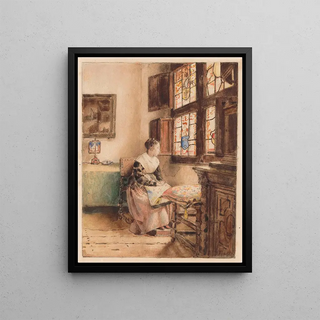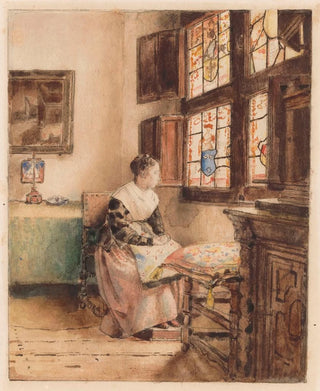Art print | Waiting - Henri de Braekeleer


View from behind

Frame (optional)
In the fascinating landscape of 19th-century Belgian art, the art print "En attendant" by Henri de Braekeleer stands out as a masterpiece, revealing the subtleties of everyday life through a poetic lens. This canvas, depicting an intimate scene, transports us to a universe where time seems to stand still. The characters, frozen in a meaningful wait, invite the viewer to reflect on the emotions and thoughts that inhabit them. The soft light bathing the composition enhances the contemplative atmosphere, creating a tangible connection between the work and those who take the time to observe it. The art print En attendant - Henri de Braekeleer allows for rediscovering this iconic piece in the comfort of your home, while preserving the essence of the original.
Style and uniqueness of the work
Braekeleer's work is distinguished by its meticulous realism and its ability to capture the nuances of human existence. "En attendant" is characterized by a delicate color palette, where warm tones and subtle shadows blend harmoniously. The choice of characters, representing familiar figures, anchors the scene in an accessible reality, while leaving room for imagination. The composition, carefully balanced, guides the viewer's eye across the canvas, revealing often overlooked details. Each element, whether facial expressions or surrounding objects, contributes to the emotional impact of the work. Thus, Braekeleer succeeds in transcending the simple painting to offer a true reflection on waiting, hope, and uncertainty.
The artist and his influence
Henri de Braekeleer, born in 1840 in Antwerp, is an emblematic figure of the Belgian realist movement. His work is deeply marked by attentive observation of daily life, a theme he explores with unique sensitivity. Influenced by masters such as Jean-François Millet and Gustave Courbet, Braekeleer develops a style that combines technical precision and sincere emotion. His ability to depict scenes of ordinary life with such psychological depth grants him a prominent place in art history.

Matte finish

View from behind

Frame (optional)
In the fascinating landscape of 19th-century Belgian art, the art print "En attendant" by Henri de Braekeleer stands out as a masterpiece, revealing the subtleties of everyday life through a poetic lens. This canvas, depicting an intimate scene, transports us to a universe where time seems to stand still. The characters, frozen in a meaningful wait, invite the viewer to reflect on the emotions and thoughts that inhabit them. The soft light bathing the composition enhances the contemplative atmosphere, creating a tangible connection between the work and those who take the time to observe it. The art print En attendant - Henri de Braekeleer allows for rediscovering this iconic piece in the comfort of your home, while preserving the essence of the original.
Style and uniqueness of the work
Braekeleer's work is distinguished by its meticulous realism and its ability to capture the nuances of human existence. "En attendant" is characterized by a delicate color palette, where warm tones and subtle shadows blend harmoniously. The choice of characters, representing familiar figures, anchors the scene in an accessible reality, while leaving room for imagination. The composition, carefully balanced, guides the viewer's eye across the canvas, revealing often overlooked details. Each element, whether facial expressions or surrounding objects, contributes to the emotional impact of the work. Thus, Braekeleer succeeds in transcending the simple painting to offer a true reflection on waiting, hope, and uncertainty.
The artist and his influence
Henri de Braekeleer, born in 1840 in Antwerp, is an emblematic figure of the Belgian realist movement. His work is deeply marked by attentive observation of daily life, a theme he explores with unique sensitivity. Influenced by masters such as Jean-François Millet and Gustave Courbet, Braekeleer develops a style that combines technical precision and sincere emotion. His ability to depict scenes of ordinary life with such psychological depth grants him a prominent place in art history.






